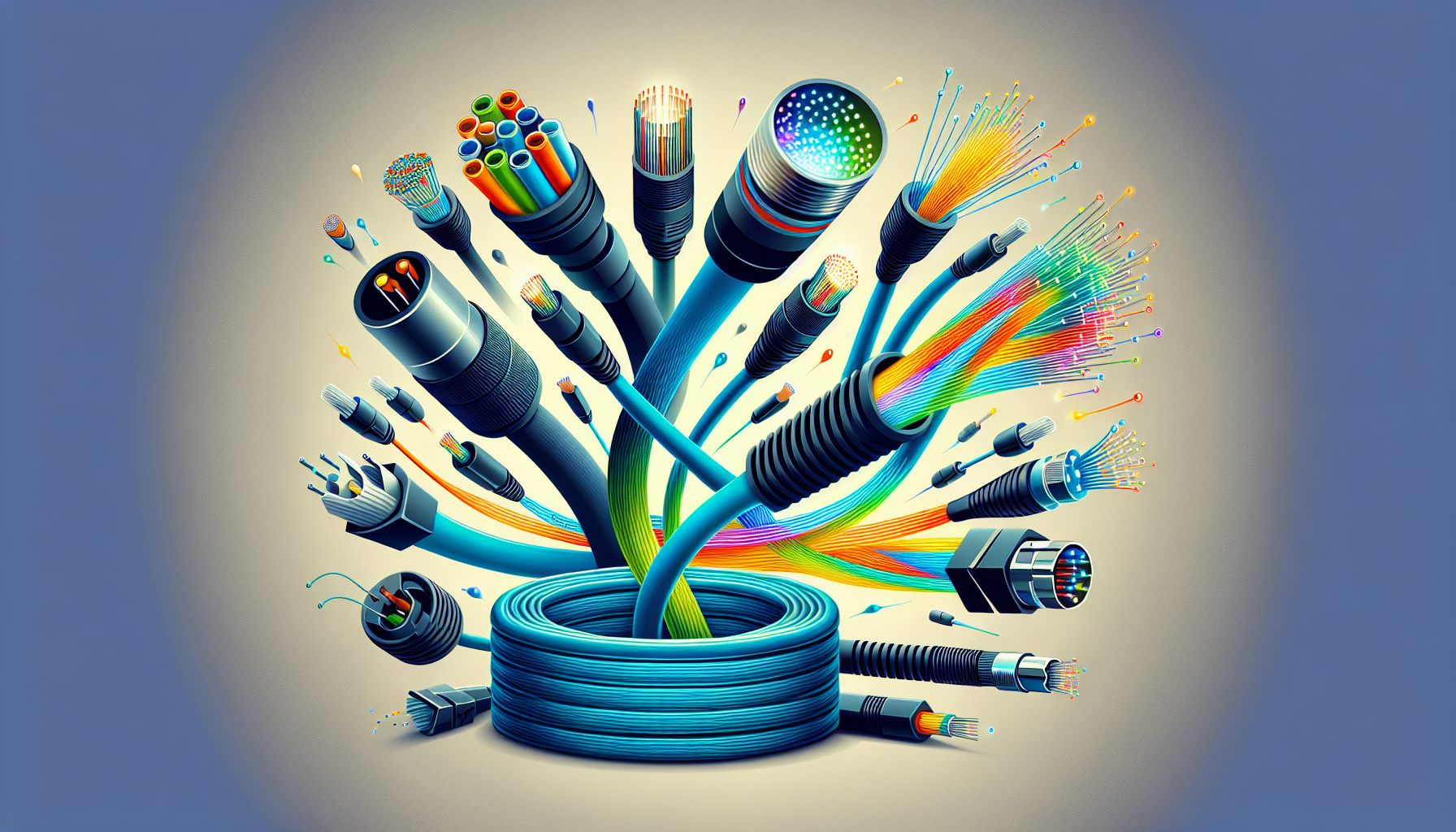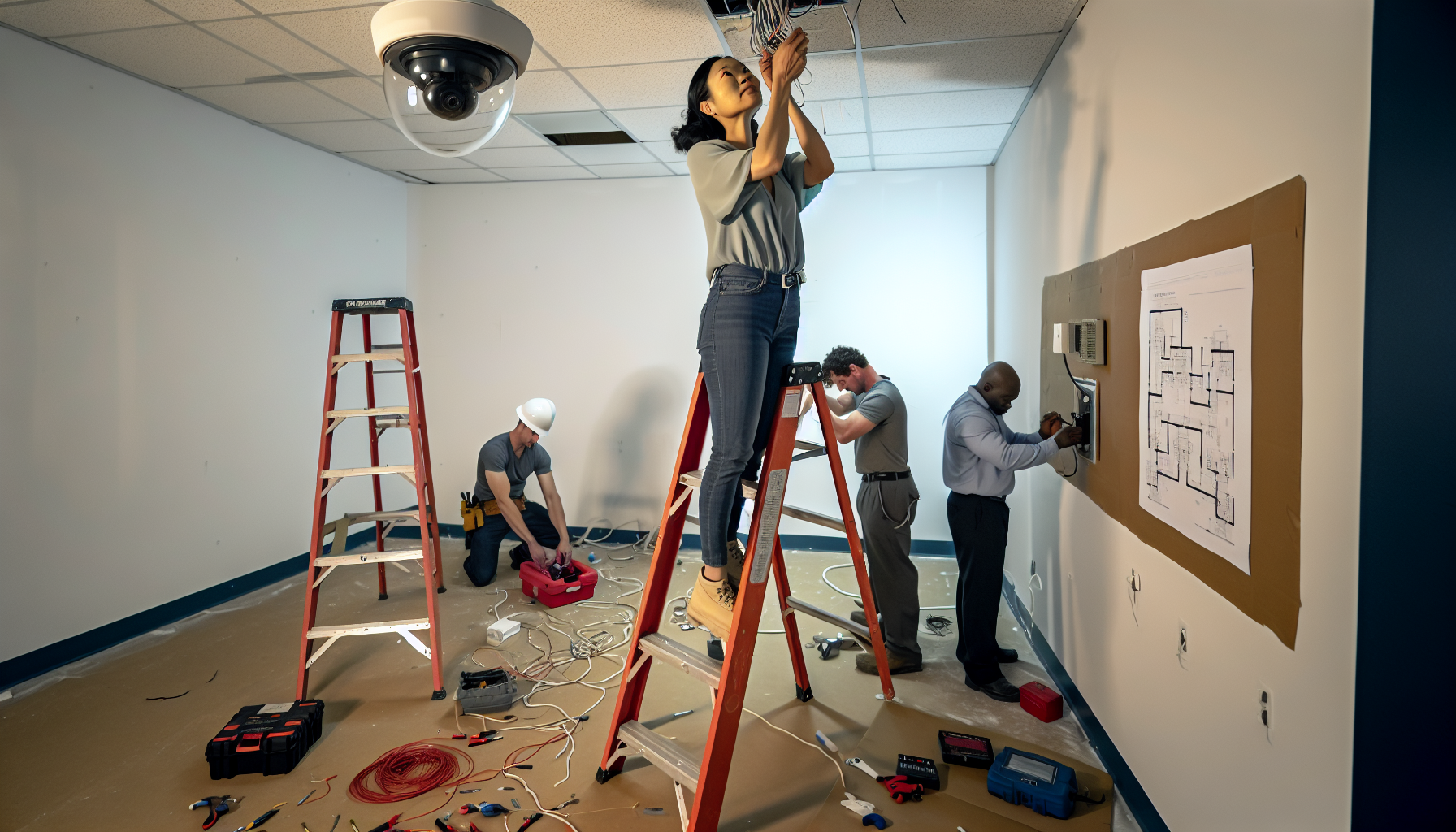Navigating the essentials of low-voltage cabling is key for efficient electronic systems in any setting. This type of cabling powers and connects devices like phones and security systems, all while conserving energy. In this guide, you’ll learn about the different types of low-voltage cabling, installation tips, and how they keep your connectivity strong and interference-free. Dive in to ensure your installation is top-notch and cost-effective.
Low voltage cabling, operating below 50 volts, is crucial for supporting various infrastructure technologies and offers benefits such as reduced power consumption and minimal electronic interference, but requires proper installation and maintenance.
Different types of low-voltage cables, like Category cables, coaxial cables, and fiber optic cables, are designed for specific uses, accommodating varying capacities for applications such as data networks, video/radio signal transmission, and high-speed data communication.
Installation best practices and managing interference are key: professional installation enhances performance and safety, while shielding and proper grounding can mitigate electromagnetic interference, which is crucial for maintaining signal integrity in low-voltage systems.

Fundamentally, low voltage cabling is a term for electrical wiring and systems that function with a minimal current. These low-voltage signals, typically below 50 volts, are vital for supporting many infrastructure technologies such as phones, security systems, fire alarms, and intercoms. We encounter low-voltage cabling in various applications, notably in data and communication transmission via telephones, Wi-Fi, and cable systems.
Security and surveillance installations also heavily rely on low voltage cabling. Low-voltage cables, generally made of conductive materials like copper or aluminum, offer several advantages:
Reduced power consumption
Compactness
Flexibility
Minimal interference with other electronic devices
All of these qualities make low-voltage cables ideal for transmitting data.
Low voltage cabling, which ensures safe operation, undergoes less stringent inspections than high voltage cabling due to a lower risk of electrocution. However, proper installation and maintenance are vital to ensure reliable functionality and the capacity to accommodate future electrical equipment upgrades.
Low voltage cabling plays a pivotal role in carrying signals in various systems, including:
Telephone systems for both voice and data transmission
WiFi and internet systems for fast and reliable data transmission
Audio and video systems, such as home theaters and commercial audio setups
Computer networks
Nonetheless, it’s important to realize that while low-voltage cables play a key role in data transmission, they aren’t the sole determinants of internet speed. Other elements such as:
the service provider
the quality and type of switch or router used
the downloading speed of the website or server being accessed which can have varying capacities also play a significant role.

When it comes to low-voltage cables, one size certainly doesn’t fit all. Different types of low-voltage cables cater to specific needs and applications. From category cables utilized for data networks to coaxial cables for video/radio signals and fiber optic cables for high-speed data transmission, each cable type is designed to accommodate varying capacities and requirements.
We will now examine each type and their respective uses.
Category cables are a common sight in data networks, with Cat 6 being a favored choice due to its balanced performance in speed, bandwidth, and cost. However, in scenarios requiring deployment in data centers or high-demand pathways, Cat 6a steps up to the plate.
Cat 6a offers the following advantages over Cat 6:
Delivering a speed of 10Gbps across the full 100-meter length
A bandwidth of 500Mhz, which is twice that of Cat 6
Sustains high-speed transmission over a longer distance
Conversely, Cat 5e cables offer a more economically viable choice for applications with limited bandwidth requirements. Limited to a maximum range of approximately 100 meters or 300 feet, Cat 5e cables are suitable for less demanding network environments.
Coaxial cables stand out for their unique construction—a solid copper center with a dielectric insulator and metallic shield—that facilitates the transmission of video or radio signals. Coaxial cables are categorized based on their impedance, with two main types being 75 Ohm and 50 Ohm cables.
What sets coaxial cables apart is their superior protection against radio frequency and electromagnetic interference. This is achieved through multiple layers of shielding, which obstruct external electromagnetic waves, ensuring a more reliable transmission of signals. The outermost shielding of the coaxial cable serves as a protective barrier, safeguarding the inner layers from external interference and averting data loss.
Stepping into the realm of high-speed data transmission, we encounter fiber optic cables. These cables utilize glass fibers to transmit light, enabling them to transmit data over longer distances and at faster speeds than traditional copper wires.
Fiber optic cables provide superior speeds and higher bandwidth than copper cables, making them ideal for transferring large amounts of data over long distances. Fiber optic cables achieve this through light pulses generated by a transmitter, which traverse the fiber optic cable at the speed of light and are detected by a receiver at the receiving end.
Fiber optic cabling is frequently utilized for networking between multiple facilities or in situations necessitating long-distance signal transmission.

Power Over Ethernet (POE) is a game-changer in low-voltage cabling. This technology facilitates the transmission of electrical power and data through Ethernet cables, allowing devices to receive data connection and electric power through a single cable.
The advantages of utilizing POE are manifold. Some of the benefits include:
Decreased installation expenses
Heightened safety measures
Greater adaptability and expandability
Enhanced LAN architecture
Reduced infrastructure expenditures
POE embodies a host of benefits.
Unsurprisingly, POE is commonly utilized in devices like:
VoIP phones
Thin clients
LCD TVs
Cameras
Consolidating data and power transmission over a single Ethernet cable proves beneficial.

Low-voltage wiring is the unsung hero behind modern security systems. It powers various components, such as CCTV, access control, and alarm systems. These systems utilize specific cables like CCTV cables, coaxial cables, Siamese cables, and Cat5/Cat6 cables for their operation.
In CCTV and surveillance systems, low-voltage wiring ensures a reliable power supply to security cameras by establishing connections to a power source. Similarly, in access control systems, low-voltage wiring facilitates power and data transmission between various components such as access control panels, card readers, and electric locks. In alarm systems, low-voltage wiring provides power to components such as the control panel, sensors, and detectors, enabling the safe and efficient transmission of power and signals.
When it comes to low-voltage cabling, proper installation isn’t just a recommendation—it’s necessary. Ensuring the correct installation practices guarantees optimal performance and enhances your system’s safety and longevity.
We will now explore the importance of professional installation and considerations for conduits.
Engaging with a specialized partner in low-voltage cable management and installation can yield numerous benefits, such as correct management and installation of cabling, reliable repair, and comprehensive system replacement. This is particularly relevant for organizations seeking to enhance or modernize their structured wiring arrangements.
Contrarily, non-professional or DIY installation of low-voltage cables can lead to many potential risks. These can range from electrocutions and eye injuries to improper wiring that can lead to potential disasters and additional labor to rectify errors. Thus, it is advisable that individuals responsible for the installation of low-voltage cables have a comprehensive education in the field, a good understanding of local requirements and regulations, training as electricians, hands-on experience in low-voltage installations, and relevant certifications or licenses.

A conduit in low-voltage cabling serves as a protective tube or pipe designed to enclose and safeguard the low-voltage wiring. This provides protection against electromagnetic interference (EMI) and radio frequencies. Conduit types commonly used for low-voltage cabling include:
PVC conduit
Rigid nonmetallic conduit (RNC)
Electrical nonmetallic tubing (ENT)
Liquid flexible nonmetallic conduit (LFNC)
Fiberglass conduit
Utilizing conduit offers a slew of benefits, such as:
Heightened protection of cables
Improved safety
Flexibility in cable routing
Improved durability
Adherence to local building codes
Although not mandatory for low voltage cabling, there are specific situations, such as electrical installations or compliance with local building codes, that necessitate the protection of cables with conduit.
Managing interference is an essential aspect that must not be overlooked within the scope of low-voltage installations. Electromagnetic interference (EMI) within low-voltage installations refers to undesired noise or disruption in the electrical pathway or circuit from external sources. This interference can lead to data corruption, degradation of signals, and diminished performance of equipment or transmission channels.
Shielded cables are one of the ways to mitigate this interference. They employ a conductive shield that envelops the inner conductors, establishing a Faraday cage to obstruct external electromagnetic fields. Grounding the shield enables the dissipation of induced currents, thereby reducing the impact of EMI.
It’s worth noting that unshielded cables, lacking this protective shield, are more vulnerable to EMI and its potential impact on signal integrity.
In network architecture, switches act as a centralized connection point for all devices on a network, enabling efficient communication among them. They operate at the OSI model’s data link layer and facilitate network device connectivity through packet switching.
When selecting the appropriate switches for a network, factors such as:
network type
speed requirements
future scalability
compatibility with existing systems
should be taken into account.
Alongside switches, cabling has a significant role in structuring networks. It establishes a standardized and organized data-transmission infrastructure, facilitating planned routing of cables and hardware to meet specific requirements. This ensures a robust, scalable, and reliable foundation for network connectivity. When selecting cables for a network, considerations like:
Internet connection speed
Cable category
Cable length
Shielding
Specific network needs
should be assessed.
While upgrading your cabling infrastructure might seem overwhelming, it could solve frequent network connectivity problems, reduced internet speeds, or expanding business requirements. Several factors should be considered when planning an upgrade, including the current state of the infrastructure, bandwidth, and speed requirements, future scalability, budget, available expertise and resources, compatibility with existing systems, and adherence to industry standards and regulations.
Recent developments suitable for upgrading low-voltage cabling include:
Environmentally sustainable products
Increasing retail demand
Rising material costs
The need for greater bandwidth
Emerging technologies
Application in solar equipment
Improved safety in installations
As for the expenses involved, enhancing the cabling infrastructure for a small to medium-sized business generally falls within the range of $2,000 to $3,000, subject to potential fluctuations based on the quantity and caliber of the cabling.
From exploring the basics of low-voltage cabling to delving into the crucial role it plays in data transmission, we’ve traversed the intricate landscape of low-voltage cabling. We’ve unraveled the types of cables and their uses, the benefits of Power Over Ethernet, and the importance of proper installation. We’ve also touched upon managing interference, structuring your network, and upgrading your cabling infrastructure. As we navigate through today’s connected world, understanding the nuances of low-voltage cabling is more crucial than ever. Here’s to harnessing the power of low-voltage cabling to fuel our technological advancements!
Low voltage cabling is used for various applications, such as data communication, audio/visual systems, security systems, and lighting control systems.
For low-voltage wiring, you can use Unshielded Twisted Pair (UTP) cable like Cat 6 or 6a cables and fiber optic cable for long-distance runs. These are some of the more common types of cables used in low-voltage applications.
Yes, Cat6 is considered low voltage because it is used for ethernet connections.
Power over Ethernet (POE) allows devices to receive data connection and electric power through a single Ethernet cable, facilitating the transmission of electrical power alongside data.
If you’re experiencing frequent network issues, slow internet, expansion needs, or outdated cabling, it may be time to consider upgrading your cabling infrastructure. Keep an eye on these signs to ensure your network’s efficiency.